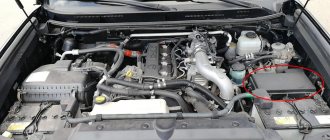Land Cruiser Prado is one of the most recognizable cars on domestic roads. It stands out from the crowd with its aggressiveness and at the same time elegance. And today, having gone a long way to the pinnacle of success, this model enjoys well-deserved popularity and recognition throughout the world. Some owners prefer quiet city driving. Others go off-road to conquer. But both of them are united by the desire to make their car unique, to further distinguish it from others.
Toyota Prado 150 - a car with excellent cross-country ability
The peculiarity of the Prado is that it is a classic frame jeep that can handle any off-road conditions. No matter how Japanese designers try to make the exterior respectable, the car’s design remains indestructible.
After two restylings, the Prado 150 became even more comfortable inside and more solid outside. Regarding off-road characteristics, the updated model still contains a solid rear axle, a spar frame and a transfer case with a reduction gear.
Ground clearance of 220 mm allows you to easily drive through ruts and holes.
Suspension geometry and a locking center differential plus the MTS electronic system make off-road driving comfortable for the driver.
The Crawl Control system deserves special mention, with the help of which the Prado can easily overcome any obstacle, be it sand or a swamp. To activate the mechanism, you will need to select the desired type of surface from the list provided and a suitable pace (1-5 km/h). The SUV will do the rest on its own.
Advantages and disadvantages of Prado 150
TLC Prado is famous for its impressive list of advantages. The jeep has an incredibly strong suspension and a reliable engine, and due to its large dimensions, the car has a large interior. A comfortable steering wheel and high seating position, combined with excellent brakes and all-wheel drive, allow the Prado to feel great off-road.
Among the advantages of the model they note:
- off-road potential;
- solid exterior;
- liquidity during resale;
- rich equipment;
- quality gearbox.
The disadvantages of the Prado SUV are typical of most frame jeeps: handling, body swaying at high speed, significant fuel consumption (for gasoline engines), expensive maintenance. According to reviews from car owners, the version with a 2.7 liter gasoline engine has poor driving dynamics.
Weaknesses of the Prado 150:
- paintwork;
- oil seals;
- transfer case;
- air suspension;
- problems with injectors;
- starter;
- cooling system.
The high cost of an SUV can hardly be considered a disadvantage, since the TLC is really worth the money.
Tuning Prado 150: installing the right body kits and large wheels
It is impossible to imagine the Prado 150 off-road without external tuning. The camshaft, aerodynamic body kits and good large tires not only give it a brutal look. They increase the car's off-road potential.
Body kits
The front body kit is installed to protect the bumper and the entire front of the car. This accessory will save the body from damage in case of careless parking or when colliding with obstacles. Japanese designers have provided for the possibility of changing the exterior of the SUV and made special fasteners for additional body kit.
For the rear of the car, special linings with wide angles are used. They protect the body from dirt and sharp impacts.
Toyota factory side skirts can be completely replaced or upgraded. Edges and door sills, chrome-plated pipes will make getting into the car comfortable for the driver and passengers. When driving on rough and swampy terrain, it is recommended to install aluminum thresholds.
Wheels
Standard Prado models are equipped with R18 size wheels. However, the Japanese manufacturer allows the SUV to be equipped with tires of various diameters: from 17 to 22 inches. The choice depends on the ambitions and driving style of the car owner.
If preference is given to quiet city driving, then R17-R19 tires will be sufficient. For off-road enthusiasts, wheels with a diameter of 20-22 inches are suitable.
Installing tires of this size in combination with forged or alloy wheels will give the car's appearance individuality and recognition. Equipping your jeep with larger wheels will improve its handling and cornering stability.
King of the city: chip tuning of Toyota Prado 150 engine (diesel and gasoline)
Car tuning should start with the engine. The solution to the problem of acceleration dynamics is achieved by installing a chip on the electronic engine control unit, which regulates the fuel supply, thereby increasing the power of the already aggressive Prado. Today there are enough offers on the market both for the chips themselves and for their proper installation.
Next, you need to move on to the appearance of the car. A good start for tuning would be the installation of light alloy wheels with a radius of 18-22, depending on the owner’s preferences, which will emphasize the expressive style of the car and give it more individuality.
New running boards and a stainless steel exhaust pipe will add brutality and greater seriousness to the car. To emphasize an aggressive driving style, you can install a split exhaust pipe - a popular practice on sports sedans.
A tuning package consisting of an aerodynamic body kit for bumpers and sills, offered both by the official manufacturer and by many third-party studios, will help make the appearance of the car more sophisticated and at the same time exclusive.
Additional accessories for tuning can include daytime running lights, a rear spoiler with a separate brake light, eyelashes on the headlights, roof rails, alternative optics and turn indicators on the car's fenders.
Owners of Prado 120 often installed chrome packages on the body of their cars. Such additions gave the cars extra shine. The same elements are available for the fourth generation and they can effectively distinguish the car from the crowd. However, it is important not to overdo it with chrome elements - if there are too many, they create the opposite effect to the expected one.
Full-fledged car tuning also includes modernization of the interior. Numerous studios offer a wide range of interior elements made of wood, which, with proper color selection, add aristocracy to the interior space. If desired, you can complement this with neon lighting of the dashboard - in the dark, the interior of the car will be transformed beyond recognition. An original solution may be to install a new steering wheel, but this solution is not for everybody - most of the offers on the market have an overtly sporty style, and the Prado is still not a racing car, but a proud SUV.
Don’t forget about lighting - many options for alternative optics to suit every taste allow you to give your car a unique look both during the day and at night. New headlights can also be complemented with original fog lights, thus transforming the light profile of the car. The taillights can also be made more expressive with chrome trim.
Suspension
Preparing the Prado 150 for off-road driving should begin with upgrading the chassis. It is better to opt for a reinforced suspension. It is recommended to install a remote tank on the rear suspension: this will create comfort by increasing the energy intensity of the car's chassis.
There are several requirements for shock absorbers: the ability to adjust the desired stiffness (depending on the condition of the road) and quick repairs. Before going off-road, it is advisable to do a couple of laps around the city. This will help evaluate the shock absorbers in operation and change their stiffness.
To equip your car with larger tires, you will need to replace the upper suspension arms. Installing new elements instead of standard spare parts will increase the suspension lift to 3.5 cm.
Modification of Prado 120 headlights
Off-Road tuning Land Cruiser Prado 120
Tuning Prado 120 headlights is a useful thing, one might even say necessary. Many owners immediately after purchase strive to somehow improve head optics . The native light is disgusting, the situation is saved by installing lenses.
There are a lot of Chinese consumer goods on sale; you can install them if you wish, but such an improvement will only last for a couple of years at most. Knowledgeable people advise not to save money and choose proven products.
Optima Premium BiLED Lens Professional
For example, lenses with LEDs Optima Premium BiLED Lens Professional Series 3.0″ 4800K . The cost is not small (about 20 thousand), but the result is worth it. Article: LENS-3.0-BiLED-PS .
second option is to buy Hella3r bi-xenon lenses , Optima blocks and D2S Osram nightbracker +70% xenon bulbs
Hella3r bi-xenon lenses, Optima blocks and D2S Osram nightbracker xenon bulbs +70%.
Of course, do not forget to polish your headlights every few years ; covering them with a protective film will not be superfluous.
Power bumper and winch
When driving off-road, you can often find yourself in a situation where a jeep, with all its power, cannot cope with an obstacle. Therefore, a winch is an indispensable accessory in off-road conditions.
This part can be installed “hiddenly” under the front bumper body kit or attached openly to the body kit itself.
Paired with a winch, the SUV is often equipped with a special towing hook in case the owner of another car needs help.
It is recommended to equip a Prado prepared for off-road use with a power bumper. This detail will reduce the risk of serious damage to the car in case of contact with stones, stumps, branches, etc. The spectacular design of the bumper with a kangaroo guard will give the SUV a brutal look.
Toyota Land Cruiser Prado 90/120/150. Off-road dudes
Eh, “seventy”... When you leave, the off-road horizon will become completely empty. One outlet remains - modern Toyota SUVs, in particular the Land Cruiser Prado, have not yet been fully glamorized. They have a frame, a solid rear axle, a non-friction clutch drive and a reduction gear. However, the front independent suspension is a definite plus for some. Moreover, there are much more Prados of the second and third generations on sale than the old paved seventies. We are talking about SUVs in J90 and J120 bodies. At the same time, let's look at the latest generation of the jeep.
The appearance of the Prado J90 in 1996 was certainly perceived as a step forward. SUVs with fully dependent suspension were far from exotic, as they are perceived now. At the same time, an example of a successful Mitsubishi Pajero loomed before my eyes. The new Toyota jeep was supposed to compete with it. However, it is still relevant today - as an alternative to younger crossovers. Prado is much more spacious, its off-road potential, in comparison with SUVs, is difficult to doubt; finally, gravel or unpaved directions will be much easier for it than some “under-drive”.
The price range for the J90 is large - 500,000–900,000 rubles, but the average cost is around 600,000–700,000. The year is not decisive; the main contribution to the numbers on the price tag is the condition of the car. At the same time, there are practically no examples with off-road preparation, but there are plenty with various kinds of body kits. There are copies without documents (about 300,000 rubles), although not as many as among the “eighties”.
The Prado J90 was offered in 3-door (body, in fact, J90, the letter R in the name of the configuration) and 5-door (J95 and T, respectively) versions, and in Europe both modifications existed in the Van version - a van. Moreover, the “five-door” was available with both a high and a standard roof, with or without glazing in the rear of the cabin, with the possibility of installing a partition behind the front seats. In 2014–16 Japanese tuning company FLEX has presented three fun modifications of the J95. The green one was called Karabomu and, in addition to the color, it was distinguished by LED lighting equipment, a roof rack, arch extensions, wheels with beadlocks, a 2-inch lift and 33-inch All Terrain tires. A Prado with wood-look paint on the sides is called American Classic. There are only visual differences here - a chrome bumper, like the Karabomu, a grille with headlights from the TLC 70, a wooden steering wheel and purple interior trim. Cruiser in faded colors is called Army. Also a 2-inch lift, larger tires, an expeditionary trunk and a deliberately simple exterior designTechnical characteristics of Toyota Land Cruiser Prado, II generation, J90 (1996–1999)
Technical characteristics of Toyota Land Cruiser Prado, II generation, J90, restyling (1999–2002)
In 1999, Prado was restyled - the radiator grille changed, and fog lights appeared. The interior of the Land Cruiser was transformed just as slightly - the photo above on the left is before restyling, on the right - after it. The five-door could have a third row of seats. Also available with leather upholstery Prado, taking into account the difference in approaches to different markets, had a lot of trim levels. Among them there were quite simple ones, like an RV for Australia (left): air conditioning, power accessories and two airbags. But specifically for the Middle East and Africa, there was STD equipment - without all this, with leatherette upholstery, an additional tank and a single 3L naturally aspirated diesel engine. There were also many special versions that differed from each other in their external body kit. In the center is the Ski version for ski lovers - with a trunk, a hood trim and corresponding stickers on the body. On the right is the Beach option - everything is the same, but in a 5-door body and a different colorBuying a Prado J120, which appeared in 2002, is easier. The offer is greater, the condition is theoretically better. If only because this SUV was often taken exclusively as a city traveling car (like a status car and all that) or for short weekend trips. True, it costs twice as much - from 800,000 to 1,500,000 rubles. More often you can find prices in the range of 1,100,000–1,350,000 rubles. There are at least cars without documents (500,000–700,000 rubles), but there are a lot of cars with left-hand drive - dealers were already working hard and everywhere.
The Prado J120 was also offered in 3- and 5-door versions. For the European, Middle Eastern and Australian markets, there was the GX package on stamped wheels, with unpainted bumpers, air conditioning and power accessories. "Arabs" could be equipped with a naturally aspirated 3.0-liter 5L-E diesel engineTechnical characteristics of Toyota Land Cruiser Prado, III generation, J120 (2002–2009)
Simple (but not spartan!) configurations were distinguished by a conventional radio without a touch screen and, accordingly, navigation, as well as the absence of an optitron instrument cluster. Long-wheelbase modifications, as before, could have three rows of seats. As an alternative, the J120, like the J90, was equipped with folding “seats” in the trunk, designed for fourThe Prado, which appeared in 2009 in the J150 body, is fresh and therefore expensive. Great luck getting it for less than one and a half million. Usually prices approach two and in many cases exceed this mark. Among the advantages, like its predecessors, is a good choice. There is also a Cruiser with right-hand drive, and the prices are no lower than for the “official” Prado. “Illegal” SUVs are meager, costing over a million.
The 2013 restyling became the most noticeable in the entire history of the Prado, radically changing the “facial expression”. A 3-door Prado is available in some markets. This is not officially supplied to RussiaTechnical characteristics of Toyota Land Cruiser Prado, IV generation, J150 (2009–2013)
Technical characteristics of Toyota Land Cruiser Prado, IV generation, J150 (2013–present)
On the left is the interior of the car before restyling, in the center - after it. Despite the fact that the Prado J150 is positioned as a luxury SUV, in Japan or, for example, in Australia, there are configurations that lack an audio system and electronic assistantsDifficult choice
As a direct descendant of the light modification of the 70 series, the Prado J90 was deprived of the five and six diesel engines, which were impressive in their reliability and service life. But he also did not receive ancient engines like 2L-TE and 22R. But the so-called UN Prado (STD version) with a 3L diesel engine is still an exception to the rule. The engine is good, and deservedly once enjoyed popularity for various types of tuning. However, if you suddenly come across a similar Prado... what mileage might it have?
Only the 3.0-liter 1KZ-TE turbodiesel was inherited. At one time, we accepted this unit after the stunted 2L as some kind of revelation from Japanese diesel engines. 140 forces and 334 Nm - not much? But even in a nearly two-ton five-door and with an automatic transmission, it made it possible to keep up with passenger cars. Which was what ruined him. In the early 2000s, we didn't have any service culture. And if the oil was changed at least somehow, then they didn’t think about the cooling system. And when the fuel supply advance angle went away...
Has the gasket blown, has the “head” become stuck? The problems with 1KZ may not end here. It often happened that the cylinder head cracked along the inter-valve bridges. The car was sold to future owners. Later, when a civilized approach emerged in operation, the “casette” proved that it could work without boiling or cracking. Nevertheless, many of the “heads” are no longer original, and the engines under the hoods are full of contract ones (the cylinder head costs 20,000–80,000 rubles, the engine costs 70,000–140,000 rubles)
The 1KZ was replaced in 2000 by the 3.0-liter 1KD-FTV with common rail. The turbodiesel has proven itself well, but long-term operation will not be completely cloudless. After 100-150 thousand km, the turbine will probably fail, but before that, the VNT servo drive (variable nozzle turbocharger, turbine with variable geometry), which is not sold separately (about 80,000 rubles), can run out of coked blades. Other noticed problems include the limited life of the viscous fan coupling and the tension roller of the drive belt of the mounted units. Of course, common rail elements are very demanding on fuel quality (a rail costs 30,000 rubles, a fuel injection pump costs about 80,000 rubles).
The 170 horsepower with 352 Newton meters 1KD-FTV (left) is generally suitable for the Prado. The 2.8-liter (177 hp, 450 Nm) 1GD-FTV (right), introduced in 2015, is even better. But competitors’ turbodiesels of comparable volume develop 200 or more “horses”
The 2.7-liter petrol four 3RZ-FE is a budget choice. An SUV with it - both J90 and J120 (installed until mid-2004) - due to poor equipment, is somewhat cheaper than diesel cars. But the engine’s appetite is normal - when driving at half pedal, you can get within 15 l/100 km. If you “drown”... Well, how to drown, overtaking on the highway with two people in the cabin is long and tedious, and if you fill the Prado with passengers and luggage in accordance with its capabilities, then the cruising speed will not be higher than 90–100 km/h.
But the 3RZ, like its successor 2TR-FE (on the right, debuted in 2004, develops 163 horsepower), is reliable and resourceful. There are known engines with mileage of about 400 thousand km. The timing chain is durable, besides, the “fours” are omnivorous and, in principle, do not suffer from minor annoying shortcomings. So choose here - they are problem-free, but they don’t drive and have a good fuel appetite
The 3.4-liter V6 5VZ-FE also loves gasoline in considerable quantities (from 18 l/100 km in the city), although it is equally undemanding in terms of its quality. But it also gives the driver much more. Despite 185 hp. and 294 Nm, the engine performs well across the entire tachometer scale.
One might even regret that this middle-aged “six” gave way to the new V6 in 2005. After all, it did not have any congenital deficiencies and was tested not only by normal use - it was and remains popular in off-road tuning
The new V6 is the 1GR-FE. With every new year that passes, the engine proves that it is from that galaxy of modern units that are called disposable. It doesn’t seem to cause minor problems, but in this series the engines already had blown cylinders closer to 150 thousand km. Thought-provoking.
4 liters with 249, 276 or 282 Prado power is enough for the eyes. You just need to remember that the service interval of 15 thousand km is from the evil one. The oil must be changed every 7–8 thousand km, otherwise there is a high risk of “losing” the CPG
Off road? Carefully!
The caution applies to a lesser extent to the 4-speed automatic transmission of the A343F - perhaps one of the best gearboxes in the world. You can burn it only by openly disregarding common sense. It’s good that it even survived to the Prado J150, where it existed on cars with 2TR-FE until 2015. On the J120 it was only adjacent to the 4.0-liter engine, and on the J90 there was no alternative at all.
The “five-speed” A750F appeared just along with the 1GR. In the literal sense, you shouldn’t strain it with off-road exercises. Otherwise, the torque converter lock will be the first to fail, even before 100 thousand km. Behind it will be the solenoids with the entire hydraulic plate, the clutches of the two upper gears and the rear, as well as the rolled-up oil pump bushing. The fluid here needs to be changed every 40 thousand km. In this situation, there is a chance that the A750, probably not completely without problems, will still survive up to 300 km.
In terms of driving performance, the “five-speed” is, of course, better than the old “automatic”, but the 4-speed A343F is used even on trophy prototypes. The A750F can burn out in conditions far from swamps. Repairs will cost around 100,000 rubles. Or more, depending on your luck
In 2015, a 6-speed automatic transmission began to be installed with all engines. With 1GR it is A760F, with other engines it is A960F. Boxes are rarely repaired due to their youth, but everything that is typical for the A750F is also typical for them. With one clarification - these automatic transmissions are even more gentle.
With the well-deserved “mechanics” of the R151F, the 90th Prado could be found in any engine version. The J120 from Japan already had it to a limited extent, and the current J150 has a manual gearbox only together with a gasoline “four”. The box, by the way, is good - known from the “seventy” and has no weak points. Like the transfer case, it is chain-type, with a center differential (in the last two generations it is Torsen). Interestingly, the co-platform Hilux Surf of the 1995 model year, with the same Full Time, had the function of disabling the front axle. In some markets, the J90 could be equipped with a Part Time transfer case (there is information that the same transmission was offered in subsequent generations), but in Russia such Prados are very rare.
Starting with the J150, the all-wheel drive transmission modes are activated not from the usual lever, but in a crossover way - from a rotating thumb and buttons. As long as the car is young and has not seen any dirt or salt, you don’t have to worry about the wiring. But there were cases when it rotted under isolation. The rear cross-axle differential on all generations of Prado could be self-locking or hard-locking
The gear ratio of the latest Prado is 2.57:1. The transfer case of previous generations of SUVs is actually the same unit, only with mechanical control
When purchasing, you should check the oil in the front gearbox and rear axle and the presence of play in the cardan shafts. And then don’t forget to change the “transmission” and tighten the shaft connections.
The front main pair is 7.5 inches in diameter, the rear is 8 inches, but this has been increased to 8.2 inches on the J150. Unlike TLC 100/105, it does not cut teeth in normal situations. Yes, and with wheels of a slightly larger diameter you can’t hear about it. All Prado axles are loaded, that is, without hubs. Stock main pairs have a ratio of 3.9 to 4.3:1. Tuned GPs are 4.88 and 5.29:1
Lift - wisely
The suspension allows you to not really choose roads and directions. Applies to all Prados, although the J120 and J150 are softer than their predecessor. When driving on hard surfaces, all elements of the front double wishbone and rear dependent suspension can last more than 100 thousand km. On the contrary, if you rely everywhere on the smooth ride and energy intensity of the chassis, then the service life of shock absorbers, ball joints or, say, stabilizer bushings can be exhausted long before 100 thousand.
The resource undoubtedly depends on the driving style - after all, a Prado of any generation allows you to move quickly on very rough roads. At the same time, for example, the lower ball joints are offered original and separately from the lever only on the J90 (about 3,000 rubles). On J120 and 150, the assembled lever costs about 15,000 rubles. As an option - non-original supports, from 700 rubles. Original springs for all generations cost between 4,000 and 9,000 rubles. About the same amount are shock absorbers. But for some reason the latter for J120 are much more expensive - 18,000 and 24,000 rubles. for front and rearThere is a high probability of investing in the KDSS - Kinetic Dynamic Suspension System. As you know, consisting of two hydraulic cylinders (replacing one stabilizer link at the front and rear), hydraulic accumulators and lines, it resists roll, and when off-road, it releases these same hydraulic cylinders, providing better articulation of the suspension. So, even before the warranty expires, the cylinders leak (about 70,000 rubles apiece). However, this only applies to the Lexus GX470 since 2004 and the Prado J150. But spending on rear air springs can also affect the owner of a previous generation SUV - for each you will have to pay about 20,000 rubles if they lose their seal. Although Toyota, unlike any Mercedes or BMW, wraps the air supports in protective corrugations.
You need to understand that the Icelandic company Arctic Trucks is preparing the Prado for certain conditions that are not as harsh as those in Russia. Still, lava fields and snow crust are hard surfaces that do not imply slipping with a possible hard hook after that, which kills the transmission. And the suspension is ready to last longer in the absence of very rough terrain. But even wheels with a diameter of 35 inches on the Prado J150 on the right are already quite a lot. And the 44 rollers on the J120 are on the left... outright overkill
It’s interesting that at least the Icelanders “tuck in” the 35th wheels by globally cutting out the arches and covering them with plastic flares. With more serious “shoes”, the mounts of the lower arms are lowered, and the steering knuckles are changed to those with elongated mounts to the upper arms.
Still, the Prado is better stock. Yes, not everything is going smoothly with his units - their choice, reliability. However, there are not a lot of shortcomings to talk about here. Everything is within the framework of current trends, but adjusted for typical Toyota values - relative unpretentiousness and resource. In a word, Prado, being in modern times, is still partly where safety margin once ruled the roost. As long as there is such an offer, you should take advantage of it.
Prado in the J120 body received a frame with crushable deformation zones. Hanging power bumpers on such a thing and then using them to cut down trees is sheer recklessness. But SUVs of the last two generations are no less safe than modern cars
Victor Melnik
Repeated winner of the Eastern Siberian championships in trophy orienteering
— Based on my experience of owning several Prados of different generations, I will say that after the 90th, the appearance of the 120th Prado in 2002 looked like a big step forward. It still seems like that to me. Much less rolly than its predecessor, the J120 has become more pleasant to drive, but also more comfortable and quieter. Yes, this is still a frame SUV with a solid rear axle. But try racing like this on broken gravel or dirt roads in some BMW or Mercedes crossover!
The J150 chassis is identical to its predecessor. But not when it comes to the KDSS system. In my opinion, it does not suit the relatively compact Prado. Or it fits, but in conditions of perfectly smooth asphalt. But the TLC 200 is a different matter, and the “little brother” turns into a tumbler - in my opinion, there is an extra buildup that KDSS must fight with. Moreover, in uneven turns (on a new car!) I was surprised by knocking noises, which were not present on the Prado without this system.
A few words must be said about the rear air suspension. Many people believe that it is stiffer than that on conventional springs. In fact, it is only shorter, and on the Lexus GX470 (at least for the 2002 model year) this is even more pronounced than on the Prado. On small bumps you don’t feel it at all, on large bumps the bump stops come into play - it’s perceived as a blow. But there is a function to maintain the height of the body when loading. Convenient, especially since the Prado allows you to load a lot - I had 8 people plus things and a trunk case on the top trunk. By the way, I’ll immediately say about the fundamental differences between the interior of the 120th Prado and the J150. In the first case, with the third row of seats, a good “rookery” is obtained. In the second, where the “gallery” is retracted into the trunk floor, it will not be possible to arrange a comfortable sleeping bag.
I won’t open America if I say that the Prado lacks a V6 turbodiesel. And I’ll add my impressions on 1KD. A noisy diesel engine loaded with vibrations that does not want to ride at low levels. In addition to the “pit,” acoustically the turbine operates at a frequency that is uncomfortable for the ear—in simple terms, it “howls.” Given the considerable, in general, cost of the Prado and its status, Toyota could fork out for a V-type.
There are no questions about reliability in general. On my current 12-year-old GX470 (mileage 200 thousand km), I only changed the rear shock absorbers. Of course, there are minor sins - for example, I know that the radiators on the 1GR leak, and because of boiling, the “heads” have to be restored - but when compared with the problems encountered in all-wheel drive vehicles from other manufacturers, these are nothing. Nevertheless, choosing a car on the secondary market is not easy - there is a lot of junk. They don't roll the Prado off-road, but with long runs.
If you are preparing him for some kind of off-road, read expeditions, then this must be done by soberly assessing the possibilities. A lift of 2 inches with shock absorbers and springs is sufficient to switch to 33 wheels. Do you need more? There are known examples when they installed 35 tires, after which they switched to a solid front axle. This is difficult to implement technically. And is there a need for this? Isn’t it easier to immediately buy an over-the-road jeep to prepare?
Protection
Additional protection for the Land Cruiser's gearbox, crankcase and engine will help protect these important units from water and dirt getting into them. The installation of such accessories is recommended for all off-road driving enthusiasts, as it will protect the underbody of the car from mechanical damage and extend the life of the car.
The exhaust system of an SUV also needs protection. To do this, the standard pipe is dismantled, and a modified snorkel is installed in its place, which removes gas exhaust at the level of the hood. Off-road tuning for the Prado 150 can be supplemented with a direct-flow muffler. This accessory will increase the power of the car, which will be an additional advantage when traveling over rough terrain.
Standard optics can be protected from accidental damage with special protective grilles. It wouldn't hurt to install an additional front light, which would make night trips safer.











